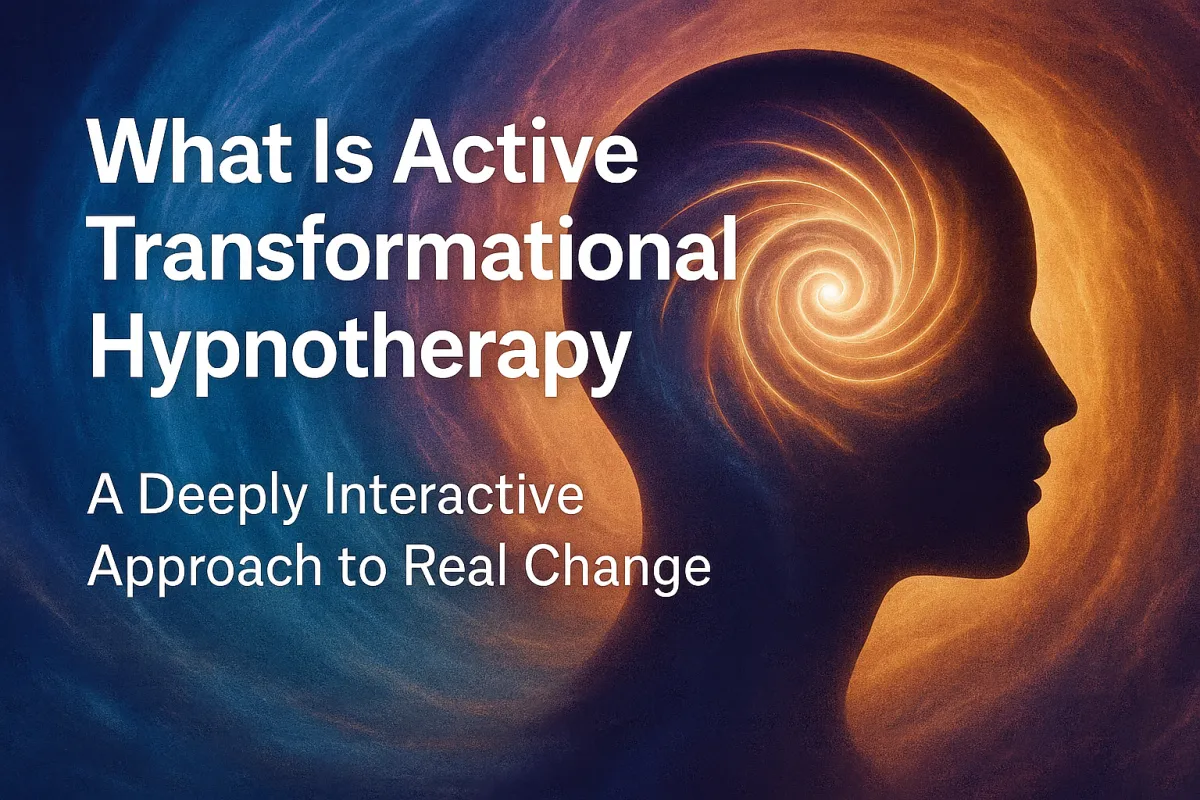
What Is Active Transformational Hypnotherapy™?
"A Deeply Interactive Approach To Real Change"
1. Introduction: Why a New Approach to Hypnotherapy?
When people hear the word “hypnosis,” they often picture someone being put to sleep, listening passively to suggestions, or clucking like a chicken on stage. But the reality is far more dynamic and alive. Hypnosis is about working with the natural ways our minds shape perception, memory, and response and modern therapeutic work should reflect that.
Traditional hypnotherapy has its value, but it can also fall into routine - scripts, formulas, or standardised techniques that don’t always match the uniqueness of the person in front of us. Human change is rarely that linear.
In my practice, hypnosis looks very different.
Active Transformational Hypnotherapy™ is a unique method I’ve developed that redefines what a hypnotherapy session can be. It’s not about scripts or passive suggestion. It’s about live interaction, deep dialogue with the unconscious, and guided shifts that emerge in real time - based on our co-creative interaction and what both you the client and me the facilitator bring forward.
This approach blends cutting-edge techniques from clinical hypnosis, psychology, neuroscience-informed coaching, and subtle unconscious communication. But more than anything, it’s an experience of real, personal transformation. Clients often describe it as both deeply scientific and mysteriously magical. One even called it “scientific sorcery.”
Instead of hypnosis being something done to you, it becomes a process of exploration done with you - an active engagement with your unconscious patterns and possibilities.
In this article, I’ll share what Active Transformational Hypnotherapy™ is, how it works, what it can help with, and why it might just be the most effective inner work you’ve never heard of.
2. What is Active Transformational Hypnotherapy™?
Active Transformational Hypnotherapy™ is an interactive, client-centered approach to hypnosis that unfolds in real time. It’s conversational, unscripted, and designed to meet the client exactly where they are - mentally, emotionally, and even physically.
It combines the depth of hypnosis with real time interaction.
Unlike conventional hypnosis, this method isn’t about putting someone “under” or reading from a set script. Instead, it works by engaging the client’s unconscious patterns as they naturally show up in conversation, posture, metaphor, breath, and rhythm. These subtle signals often tell us far more than the surface story - and they point directly to how a problem is being held in place beneath awareness.
We don’t treat the issue as a fixed label to resolve. We explore it as a structure - a set of interlocking beliefs, sensations, memories, expectations, and meanings. And we do that gently, through dialogue, presence, and hypnotic techniques woven into natural interaction.
It may not always look like hypnosis in the traditional sense. But it’s deeply hypnotic- because it works at the level where experience is constructed. That’s what makes it transformative. And that’s what makes it active.
In short, ATH is not about “putting someone under hypnosis.” It is about activating the mind’s natural capacity to reorganize itself, and creating the conditions where transformation can unfold.
Thus the key qualities of ATH are:
Interactive - built on conversation and feedback and not in one-way suggestion.
Adaptive - techniques shift according to the client’s needs and responses in real time.
Immersive - engages the structure of experience itself going beyond surface thoughts.
Transformational - focused on lasting change by working with the unconscious and not just symptom relief.
The following table highlights the differences from traditional hypnosis.
Active Transformational Hypnotherapy™ vs. Traditional Hypnosis
From Traditional Hypnosis to Active Transformational Hypnotherapy™
From Scripted inductions and suggestions to Conversational, adaptive, co-created in real time
From Client is mostly passive to Client is actively engaged throughout
From Focus on surface-level change to Works with the structure of unconscious patterns
From One-size-fits-all scripts to Tailored uniquely to each client
From Therapist “does hypnosis to” the client to Therapist and client shape the process together
In ATH, hypnosis is not something done to you - it is something you and I actively create.
3. The Science Behind The Method
Modern research confirms what experienced hypnotists have always known: people have a natural ability to alter the way they experience reality. Hypnosis isn’t something imposed from the outside - it arises from the interaction of the person’s own biology, psychology, and social context.
And in developing Active Transformational Hypnotherapy™ I got informed both from my own experience and the decades of research on how hypnosis works and what makes therapy effective.
The 3 essential scientific pillars behind the method are:
a) Hypnotic responsiveness is natural.
Paul Dell’s work on the sources of hypnotic responses shows how deeply these responses are tied to unconscious processes already active in everyday life (Dell, 2024; Dienes & Perner, 2007). Hypnosis doesn’t create something foreign - it channels and focuses what the mind is already doing. This agrees with the practical rule expressed by Clark Hull in 1933 "Anything that assumes trance, causes trance…".
Hypnotic responses are part of our everyday mental repertoire and ATH makes use of this responsiveness in an intentional & structured way.
This also sets aside the old argument if everyone can experience hypnosis or not. Short answer YES. Not only everyone can, but also everyone is.
b) It is a biopsychosocial process.
Mark Jensen and colleagues have advanced the biopsychosocial model of hypnosis (Jensen et al.,2015), demonstrating that hypnotic responsiveness is not a fixed trait but a dynamic interplay of:
Biological factors (nervous system sensitivity, pain modulation),
Psychological factors (imagination, attention, expectation), and
Social factors (the therapeutic relationship and cultural context).
This models shows how hypnotic responses can be very diverse. Setting matters and as such the behaviour of participants in a stage hypnosis show is very different compared to the coaching or therapy session. Context is gold!
ATH draws on this model by engaging mind, body, and relational dynamics together instead of treating hypnosis as a purely mental event.
c) The common factors of change.
At the same time, the Common Factors Approach in psychotherapy shows that the most reliable predictors of change are not the specific techniques used, but universal elements such as trust, alliance, emotional resonance, and the client’s expectation of improvement (Cuijpers et al. 2019 ; Wampold & Imel).
Active Transformational Hypnotherapy™ builds on these insights. By working directly with the immersive structure of experience - the way attention, emotion, memory, and meaning interweave - it amplifies the very common factors that research identifies as central to therapeutic change.
This is also why the method resonates so strongly with theatre. Both hypnosis and theatre rely on immersion, suggestion, metaphor, and presence to reshape experience. Theatre externalises the transformation for an audience. Hypnosis internalises it for the self.
Active Transformational Hypnotherapy™ combines the strengths of both - grounded in science, enriched by art, and applied with precision in the therapeutic encounter.
4. How It Works In Practice
A session of Active Transformational Hypnotherapy™ doesn’t follow a script. It unfolds in response to the client, moment by moment.
We begin with intention. What do you want to shift, release, or understand more deeply? From there, we step into a dialogue that isn’t just about words - it’s about tone, pauses, gestures, metaphors, and the unconscious cues that are always present beneath the surface.
As the facilitator, I listen for these signals. They reveal how a problem is being held together - through loops of thought, body tension, unspoken imagery, or forgotten assumptions. When these hidden threads are gently brought into awareness, the structure of the issue begins to loosen.
The work is active because the client participates fully. You remain awake, aware, and engaged throughout the process. And it is hypnotic because together we’re interacting with the unconscious - the part of the mind that organises emotions, memories, beliefs, and bodily states.
In practice, this might mean guiding someone to explore a metaphor that emerged spontaneously, shifting attention to the physical sensation of release, or reframing a story that once felt immovable. Each step is co-created - never imposed.
For example, a client once came in saying they wanted to “stop procrastinating.” At first glance, this seemed like a simple productivity issue. But as we worked, subtle cues revealed something deeper: a heaviness in the chest whenever they imagined finishing their project, and a recurring phrase - “If I complete this, everything will change.” By following those threads, we discovered the real block wasn’t procrastination at all - it was fear of identity shift. Once that deeper layer was reframed and released, the surface problem dissolved naturally.
Clients often describe the experience as both surprising and natural, as if their deeper self had been waiting for the right invitation to bring clarity and freedom forward.
5. A typical Session flow
A typical session flow looks like this:
1. Opening conversation - We begin by exploring what brings you in. More importantly, I listen for unconscious cues in the way you describe your experience - patterns in language, subtle shifts in attention, metaphors you naturally use.
2. Interactive deepening - Instead of a scripted induction, we co-create a state of focused absorption. This may involve imagery, shifts in perspective, or simple adjustments in awareness. You remain active in this process; I guide, but you participate.
3. Working with the unconscious - Here is where transformation begins. We explore unconscious patterns - automatic reactions, limiting beliefs, unprocessed experiences - and reorganize them through suggestion, dialogue, and experiential shifts.
4. Real-time adaptation - At every moment, I adjust the process to your responses. Silence, words, imagery, or even a change in posture can redirect the flow. This responsiveness is what makes ATH both precise and personal.
5. Integration - Before closing, we anchor new ways of experiencing into daily life. The aim is not just temporary relief, but sustainable change that carries forward outside the session.
Unlike traditional hypnosis, which may follow a script regardless of who is sitting in front of the therapist, ATH treats each session as unique. The method is active, alive, and shaped by the individuality of the client.
6. What Can It Help With?
People often come to hypnotherapy looking to move past limitations they couldn’t shift on their own. Because Active Transformational Hypnotherapy™ works at the level of the unconscious structures that shape our experience, its applications are broad. We’re not just managing symptoms - we’re engaging the deeper framework that generates them. This makes the same process useful for both resolving difficulties and opening new ways of experiencing life.
Some of the areas where clients see change include:
Emotional balance – moving from reactivity, trauma and stress into clarity, calm, and resilience.
Confidence & self-expression – letting go of unconscious blocks so you can show up more fully in relationships, work, or creative pursuits.
Clarity in decision-making – accessing deeper alignment so choices feel less like battles and more like natural steps forward.
Relationships & intimacy – improving how you connect, communicate, and allow closeness.
Weight & body image – releasing old patterns around eating and self-perception while cultivating healthier, more empowered habits.
Mind–body integration – reducing the grip of chronic tension or pain and allowing the body to support healing.
The common thread across all of these areas is not the label of the problem - it’s the underlying structure of experience. When that structure shifts, new possibilities open with the emergence of a stronger, freer version of yourself- one that feels more at home in its own mind and body.
7. Client Experience & Feedback
Clients often describe their sessions as both deeply scientific and mysteriously magical—an experience of clarity and release that feels natural, yet surprising.
Dakota (Google review):
“Working with Orestis was a powerful experience. His approach isn’t just about surface-level solutions - he has a way of guiding you to uncover the deeper, often hidden, patterns that are quietly running the show. Through our work together, I was able to detach from emotional reactions that weren’t serving me and instead move into a space of clarity, calm, and conscious choice.”
> “There was a physical sensation - like a burden I didn’t even know I was carrying - and through his intuitive process, I felt it release.”
Dakota’s experience captures what many clients say: a shift from emotional entanglement into grounded awareness.
Another client (shared under an alias in their Google review):
“Orestis helped me in only 3 sessions to find my inner stability. I was suffering from insomnia and rheumatic pains… After our sessions, the cravings stopped, I was able to sleep, and the pain eased.”
> “My blood test showed that the inflammation markers were for the first time at normal levels.”
This client’s story highlights how unconscious shifts can ripple through body and mind—transforming not only emotions but measurable health outcomes.
These are just two examples of what can happen when unconscious structures shift. Clients often say they feel lighter, clearer, and more capable of making choices that once felt impossible.
8. My Journey: From Physics to Transformation
The path to Active Transformational Hypnotherapy™ wasn’t planned. It grew out of the unusual intersections of my own life.
Before I became a hypnotherapist, I spent years as a theoretical physicist. My work focused on black holes, quantum gravity, and string theory - fields that demand precision, curiosity, and the ability to navigate complexity.
Day after day, I studied the invisible structures that hold together our universe - patterns you can’t see directly, but that shape everything around them. What I didn’t know then was that I was training the very skill I use today: learning to detect hidden structures and find the openings where change becomes possible.
My own path also included living with anxiety & chronic pain. Hypnosis and mind - body approaches were among the few things that made a real difference. Experiencing that shift firsthand gave me the drive to study hypnosis formally and to share it with others.
So when I turned to hypnotherapy and coaching, I naturally found myself drawn to the same territory - except this time the “structures” were human: beliefs, patterns of thought, unconscious signals. Training with the Mike Mandel Hypnosis Academy, Enter The Loop, OldPain2Go, Client Shifts Academy, and parts therapy methods gave me tools to explore this terrain. But something still felt missing: a way to bring it all together, alive and responsive, instead of boxed into techniques.
That’s when my background in theatre - improv, clowning, and music - clicked into place. Theatre had taught me about immersion, presence, and the transformation that happens when people enter a shared imaginative space. I began to see that hypnosis and theatre were mirrors of each other: both create altered realities, both shift identity, both rely on rhythm, story, and resonance.
Active Transformational Hypnotherapy™ grew out of these worlds colliding - science, therapy, and art. It’s my way of weaving them into a living method that feels both precise and creative, structured and alive. And perhaps most importantly, it’s a method that honors the uniqueness of each client in every moment.
9. What Makes It Different
There are many approaches to hypnotherapy, and each has its strengths. What makes Active Transformational Hypnotherapy™ different is not just the techniques it uses, but the way it brings them to life.
Interactive, not scripted. Instead of relying on pre-written suggestions, every session unfolds in real time, shaped by our dialogue and the client’s unconscious responses.
Client-centered, not imposed. The process is co-created. The client remains aware, engaged, and in charge of their own transformation.
Immersive, not mechanical. Change doesn’t come from surface words - it comes from working with the structure of experience itself: the rhythms, stories, sensations, and meanings that make up our inner world.
Integrative, not limited. Techniques like NLP, EFT, regression, timelines, acceptance-based approaches, and parts work are all woven together in a hypnotic way - delivered through immersion rather than as isolated methods.
In short, Active Transformational Hypnotherapy™ is hypnosis done hypnotically. It’s not about stacking more techniques - it’s about entering the right level of engagement where any technique becomes more effective, more natural, and more transformative.
Clients often say that while the process feels very different from what they expected hypnosis to be, the results speak for themselves.
10. The Future of Active Transformational Hypnotherapy™
For now, Active Transformational Hypnotherapy™ lives mostly in the sessions I share with my clients. Each meeting is unique, shaped by the co-creative process between facilitator and client.
But this approach was never meant to stay with me alone. The framework is designed to be taught, shared, and adapted - so that other practitioners can bring it into their own work. Therapists, coaches, facilitators, and guides of all kinds can use it to make their methods more immersive, responsive, and alive.
That’s why my long-term vision is not only to offer this to individual clients, but also to train others in the method. To pass it on in a way that honors its roots in science, psychology, and art, while keeping it flexible enough to evolve with the person who uses it.
For now, the best way to understand it is to experience it. But in the future, I see Active Transformational Hypnotherapy™ becoming a shared language for transformation—one that helps both practitioners and clients access change at its deepest level.
11. Conclusion & Invitation
At its heart, Active Transformational Hypnotherapy™ is about creating the space where the unconscious can speak - and where change becomes possible in ways that surprise us. It is not something done to you, but something we co-create together.
The process is active, alive, and deeply personal. It works with the very structures that shape your experience, helping you release what no longer serves and step into new ways of being. Whether the focus is healing, clarity, creativity, or growth, the method adapts to you - because that is where transformation begins.
If you feel called to explore this work, I invite you to experience it for yourself. One session can be enough to glimpse what’s possible; a series can open entirely new pathways.
When you’re ready, the next step is simple: reach out, and let’s begin the conversation.
If you’re ready to make the shifts you always desired then Active Transformational Hypnotherapy™ is for you. You can book a session directly through my website:
Sessions are available online and in person in Prague, Czech Republic.
12. Frequently Asked Questions
Will I be unconscious during hypnosis?
No. In Active Transformational Hypnotherapy™, you remain awake, aware, and engaged. The process is about working with your unconscious patterns while you stay fully present. Many clients are surprised by how natural it feels—less like “going under” and more like entering a deeper conversation with yourself.
What if I can’t be hypnotized?
Research shows that hypnosis is a natural human ability (Dell, 2024). Everyone enters hypnotic states daily—when daydreaming, getting lost in a movie, or absorbed in creative work. This approach doesn’t rely on “hypnotizability” as a trait; it works by engaging your unique way of experiencing the world.
How is this different from traditional hypnotherapy?
Traditional hypnosis often uses scripts or pre-set suggestions. Active Transformational Hypnotherapy™ is fully interactive and personalized. The session adapts in real time to what emerges, weaving together methods from hypnotherapy, psychology, and coaching into a co-created process.
What kinds of issues can it help with?
From anxiety, insomnia, and chronic pain to decision-making, weight loss, intimacy, and creativity—this approach works by shifting the unconscious structures that hold problems (and possibilities) in place. That’s why it’s so versatile.
How many sessions will I need?
It depends on your goals. Some people experience a major shift in a single session; others find a series is needed for deeper work. We decide together what best supports your outcome. Most people get maximum benefit between 3 and 6 sessions.
Does it work online as well as in person?
Yes. Because ATH is conversational and interactive, it works very well online. Many clients choose to work with me this way, while others prefer to come in person.
Is it safe?
Yes. You are always in control. Nothing happens without your consent, and you can pause or stop at any time. The process is designed to be respectful, collaborative, and aligned with your intention.
13. 📚References
Dell, P. F. (2024). What is the Source of Hypnotic Responses? International Journal of Clinical and Experimental Hypnosis 2024 Jan-Mar;72(1):64-83. https://pubmed.ncbi.nlm.nih.gov/38060715/
Dienes Z. & Perner F. (2007). Executive control without conscious awareness: The cold control theory of hypnosis. Hypnosis and conscious states: The cognitive neuroscience perspective (pp. 293–314). Oxford University Press. https://psycnet.apa.org/record/2007-02808-016
Jensen, M. P., Adachi, T., et al. (2015). Mechanisms of Hypnosis: Towards the development of a biopsychosocial model. International Journal of Clinical and Experimental Hypnosis 2015;63(1):34–75, https://pmc.ncbi.nlm.nih.gov/articles/PMC4220267
Pim Cuijpers, Mirjam Reijnders & Marcus J.H. Huibers (2019). The Role of Common Factors in Psychotherapy Outcomes. Annual Review of Clinical Psychology Vol. 15:207-231 https://www.annualreviews.org/content/journals/10.1146/annurev-clinpsy-050718-095424
Wampold, B. E., & Imel, Z. E. (2015). The Great Psychotherapy Debate: The Evidence for What Makes Psychotherapy Work. Routledge. https://psycnet.apa.org/record/2008-07548-000
These works highlight the natural basis of hypnotic responsiveness, the biopsychosocial model of hypnosis, and the importance of common therapeutic factors such as alliance, expectancy, and immersion, all of which are central to ATH.
14. Getting Started
If you are curious about how Active Transformational Hypnotherapy™ could support you, there are a few simple ways to begin:
Book a one-to-one session - available both online and in person in Prague.
Join a workshop - immersive group experiences where you can explore the method in a shared setting.
Reach out directly - sometimes the best first step is simply a conversation.
You can find details and booking options on my website: https://orestisv.com
Transformation does not begin with a script. It begins with a choice to step into the process.





